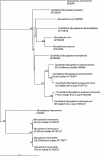Demonstration of two distinct hemotropic mycoplasmas in French dogs
- PMID: 15528754
- PMCID: PMC525152
- DOI: 10.1128/JCM.42.11.5397-5399.2004
Demonstration of two distinct hemotropic mycoplasmas in French dogs
Abstract
In North America it has been shown that distinct hemotropic mycoplasmas exist in dogs. Blood samples from 460 French dogs were analyzed by PCR to evaluate hemoplasma infection status. Seventy-one dogs (15.4%) were positive; of these, 44 (9.6%) were infected with an organism closely related to "Candidatus Mycoplasma haemoparvum" only, 15 (3.3%) were infected with Mycoplasma haemocanis only, and 12 dogs (2.6%) were dually infected with both organisms.
Figures

References
-
- Bellamy, J. E., P. S. MacWilliams, and G. P. Searcy. 1978. Cold-agglutinin hemolytic anaemia and Haemobartonella canis infection in a dog. J. Am. Vet. Med. Assoc. 173:397-401. - PubMed
-
- Benjamin, M. M., and W. V. Lumb. 1959. Haemobartonella canis infection in a dog. J. Am. Vet. Med. Assoc. 135:388-390. - PubMed
-
- Brinson, J. J., and J. B. Messick. 2001. Use of a polymerase chain reaction assay for detection of Haemobartonella canis in a dog. J. Am. Vet. Med. Assoc. 218:1943-1945. - PubMed
-
- Carr, D. T., and H. E. Essex. 1944. Bartonellosis: a cause of severe anaemia in splenectomised dogs. Proc. Soc. Exp. Biol. Med. 57:44-45.
Publication types
MeSH terms
Substances
Associated data
- Actions
LinkOut - more resources
Full Text Sources
Other Literature Sources
Molecular Biology Databases

